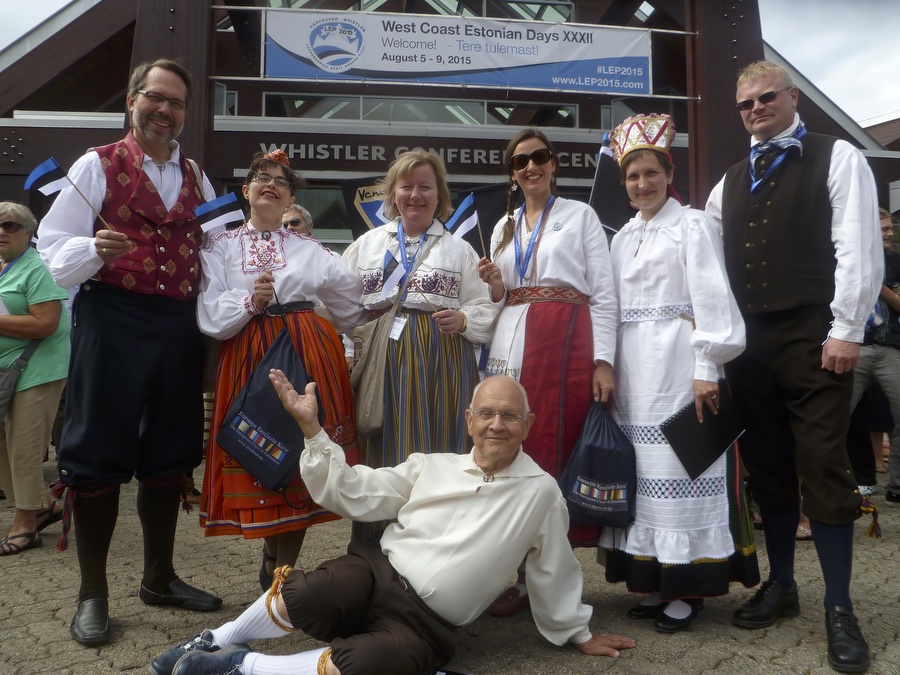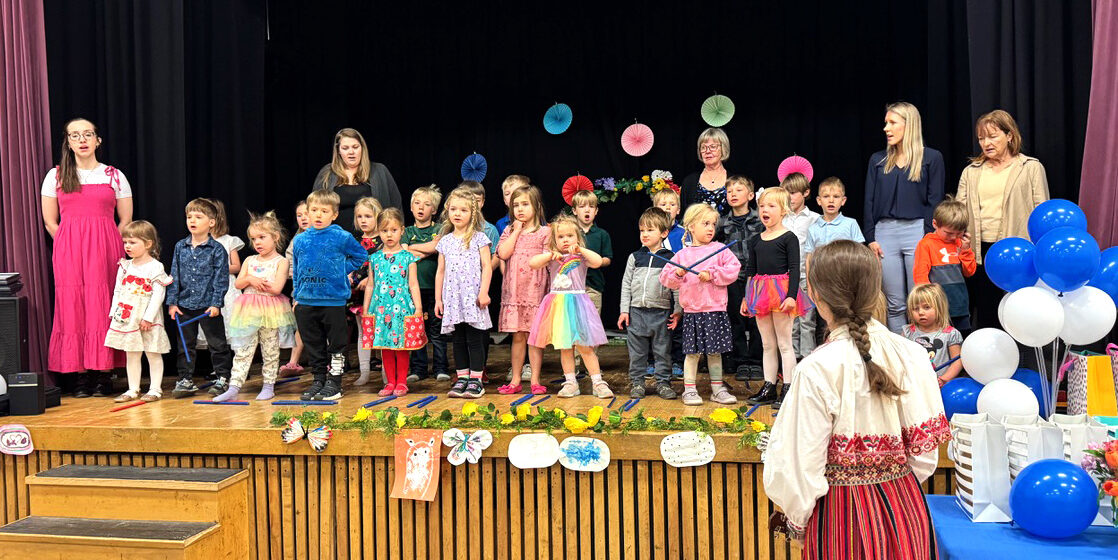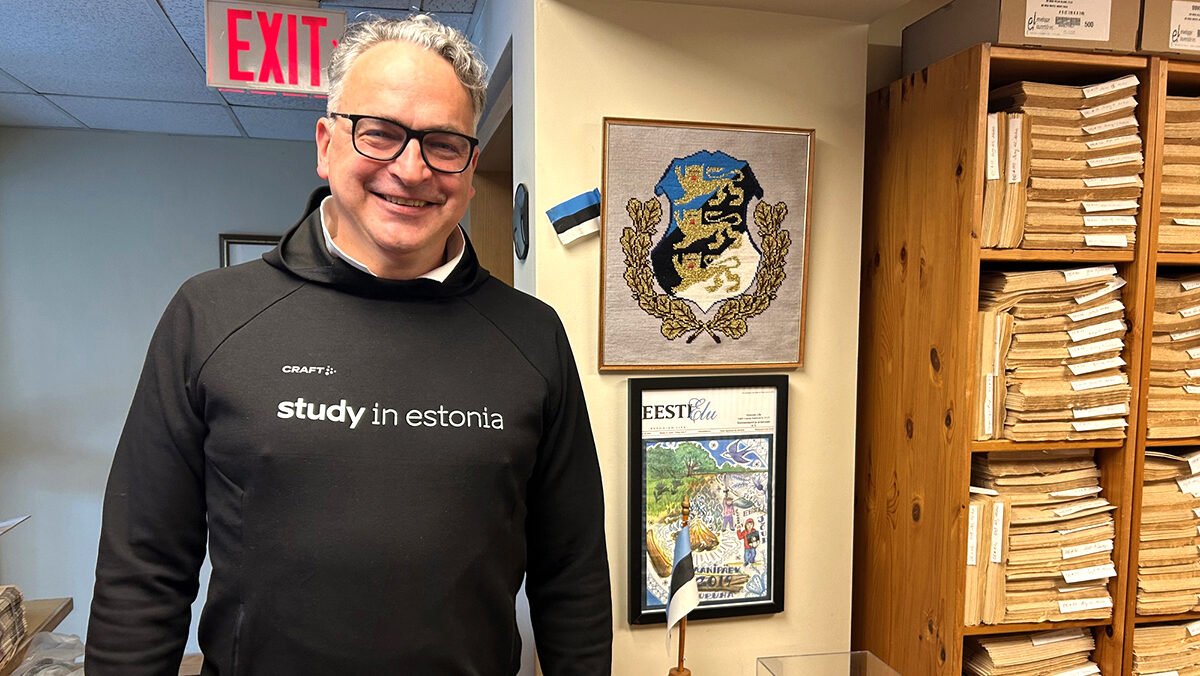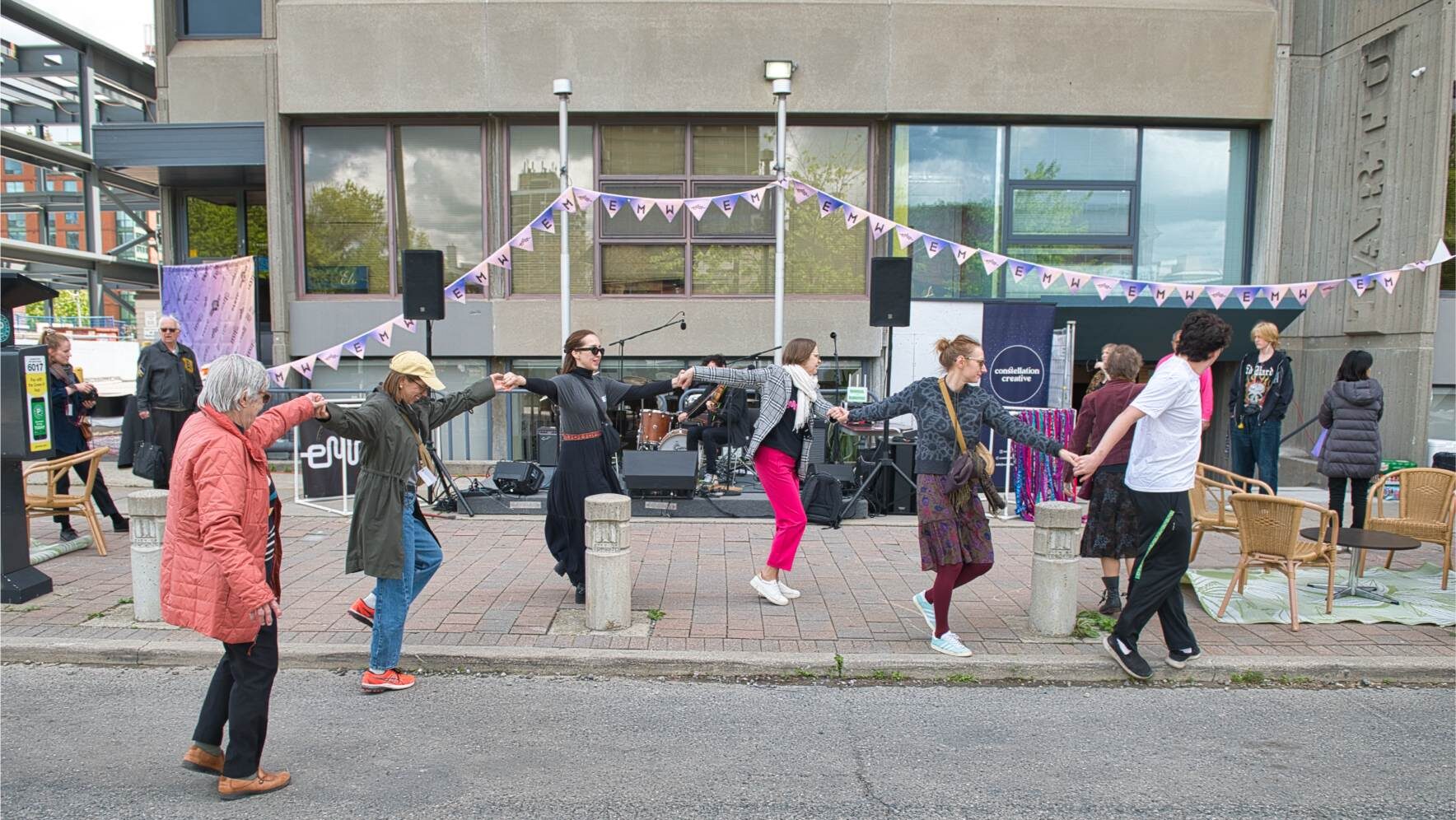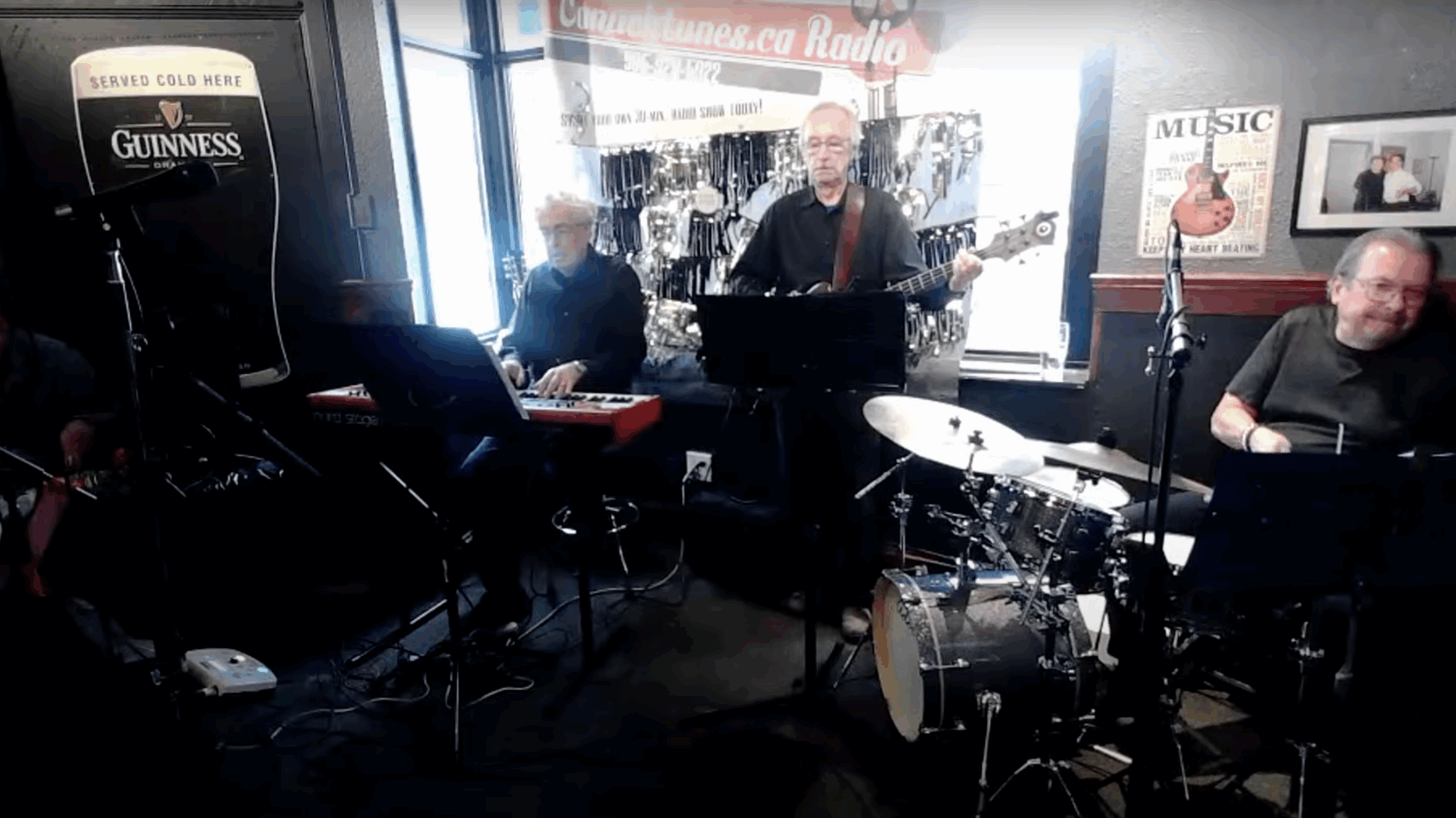Those who came from afar most likely flew into Vancouver Airport and then traveled two hours northward by bus to Whistler. This is what I did. The plane ride was boring; it used to be easy to start conversations with people within earshot. But now most travelers wore earplugs and were in their own world, as if to say: “don't bother me!” At the approach to the sunbathed Vancouver the view was beautiful: Emerald city! I thought.
The bus ride to Whistler was better. On this occasion anyone on the bus with graying hair most likely was an Estonian on the way to LEP and soon lively conversations ensued. At our destination we disembarked at Hotel Hilton where most of the activities were held.
Whistler is designed for skiers. I went to a cramped coffee shop after noting the cost of the breakfast menu at our hotel. It was the La Brassiere. Chairs and tables were crowed just like skiers like it even when wearing heavy parkas. It helps to keep warm and encourages making friendships. The taste of coffee was terrible but the price was right. The guests from south of the Canadian border could buy the Canadian dollars for 77 cents US. Thus the breakfast was a bargain.
At the registration desk in the Hilton lobby the arrivals were greeted by a smiling people. Many were wearing shirts marked “KRUU” (read as in crew). How we have changed! Every century-old photograph of Estonians has serious faces; as if they might give too much away of themselves if they smiled. But here people smiled. Some even hugged – something I am still not comfortable with! I was handed in an envelope my tickets and a very professional looking program. The treasurer, Alar Suurkask said that about 400 people had preregistered and that he expected additional arrivals whom he was prepared to liberate of their money for tickets.
The West Coast Days i.e. LEP spanned from Tuesday to Sunday during which we celebrated al things Estonian. We will get to the Tuljak later. But first some impressions of these six day.
On the first day two films could be viewed, both produced in Estonia, one with dark humor, proving that women are the smarter sex. The other film depicted the daily life of people deported to Siberia during Soviet occupation. Men and women were separated and had to live on hope for a reunion. However the film ended sadly. The film used a novel way of presenting time lapses. The gray-haired in the audience could relate very well to what was shown, but I wondered what it meant to the younger folk present. After all they did not have the benefit of knowing the context of the events. My thought was of gratitude to my parents that they decided to flee in 1944.
The following days were fully packed with performances and lectures starting with the opening gala. The writer here could not participate in many events given that both choir and dance practices coincided with many of them. But people who understand Estonian will have found all adequately covered by the professional newspaper reporters of Eesti Elu. I will just add some impressions or fill in some gaps.
Our LEP has changed and will continue to change in both attendance and content. It is interesting to observe who were present and who were missing. Present were the people to who could travel health-wise and who could afford the cost of travel and accommodations.
Missing was the aging component of the mass emigration of 1948 – 1951. For example those who had attended the Geislingen Estonian Gymnasium take pride of having been inculcated with patriotism by our school director Karl Urm, and we always show up. At ESTO2000 held in Toronto 15 years ago 50 former students gathered for a photo-op. Now here at Whistler were only 8 or 9 of us. We were especially saddened to hear that maestro Taavo Virkhaus, our famous school mate (and my one time bench-mate) who was expected to attend had to cancel due to a sudden downturn of his health.
Of the Toronto Estonian Men's Choir perhaps only three or four were present. This was most likely because of the age of the men and distance.
Some of the KRUU who manned the registration desk had to miss some performances. Similarly those who had to rehearse for the folk dance or the song festival missed even more.
Because the scheduled rehearsal this writer heard only the beginning of the ERKÜ and EKN Congress. Here Mrs. Maarja Lõhmus talked about Estonian identity and how it developed in the 19th century. It was interesting if not hard to accept: so for millenniums we had a language but no identity! I thought that our Estonian identity comes with our mother's milk and the first language the baby utters.
At this point I had to leave. If the presentation was leading up to how to preserve our identity in America I would have offered the following thoughts:
1) We must recognize that our community is contracting due to the aging of the emigres from refugee camps. The influx of new blood from Estonia does not make up for it.
2) We must accept that maintaining what we have can only done locally in our larger Estonian communities by volunteers.
3) We must therefore encourage and award the people who are leading our folk dance rehearsal, choirs and Sunday schools. For example presidential service medals should do the trick. Deserving candidates with a long service records were even present at Whistler.
4) We should use as much local talent as possible at events such as LEP. It is wonderful that so many talented groups have come here from Estonia to perform. (About ½ of the performances were theirs.) But I fear that local talent cannot compete with the best that Estonia can provide with subsidies. A case in point: A mini-opera composed by Lembit Becher, a grandson of an emigrant, won a prize in a prestigious competition. But it has not yet been performed to an Estonian audience.
5) It is unrealistic to expect monetary support from Estonia for our local activities. We can rely only on our central organizations in Canada (EKN) and the U.S. (ERKÜ) to channel contributions to subsidize Estonian cultural activities, especially for children. So we must keep up our contributions to them. The message is clear: send money!
Sadly I left the congress before it got to Ms. Lõhmus' novel proposal for developing a virtual Estonian community using the Internet to tie us. This would overcome the problem that we are so dispersed. She called it Portal “ESTICA”; to translate loosely she called us “to do this thing!”
So to the rehearsal for the song festival. This gave me a unique opportunity to converse with some of the participants. At the beginning of the rehearsal the many choirs present were introduced. Present at the rehearsal were, but not acknowledged were members of the Estonian European Choir (EEK). These are Estonians working in various European countries as administrators, teachers, doctors and representatives. They came here on their own expense. Again I asked why? One answer was that they were curious about “us” and also because they had not seen this part of the world before, and most important, they loved to sing.
Among the choirs introduced was the Chamber Choir “Unistus” (Dream). None of the singers were Estonians, had Estonian parents or spoke Estonian. I asked Joshua Kauffmann of the choir what attracted him to this choir. It was the love of singing, the songs they sung and their choir director.
The choir is directed by Mr. Lonnie Cline who favors Estonian songs, especially Veljo Tormis compositions. I happen to sit next to Mr. Cline at an event. He said that the choir has 40 members – most of them past students of a college near Portland, Oregon. Of them 25 came to sing at Whistler on their own expense. Mr. Cline said he had retired three years ago but will continue to direct the choir as long as it is fun. At Whistler his choir sang at the festival in the combined festival choir but also gave separate performances. The choir has been singing at all West Coast Estonian Days and Estonian Song and Dance festivals in Tallinn that I can remember. Though not an Estonian he should be recognized formally for promoting our culture with a service medal.
From Estonia two choirs were present: the Saaremaa Men's Choir and E STuudio Youth Choir. The rest were choirs of the West Coast Estonian centers.
The choir rehearsal went well for me given that all but one song were familiar to me having sung them with the Toronto Estonian Men's choir (TEM) in the past years as directed by Charles Kipper. TEM is the largest men's choir outside of Estonia, but because of the distance or age of the singers only a couple men were present. However maestro Kipper was here and accompanied the solos of Stephen Bell at the opening gala.
That evening I attended the Opening Gala held at a Whistler's Convention center. The gala exceeded expectations with the fast paced performances of great variety. It started with the ceremony of emblems of past LEP's being carried into the hall followed by greetings of dignitaries, solos, choral singing, bands and ballet.
Thinking of myself as one of the “press corps” (anointed by this newspaper), I seated myself in the front row, to get better photos, though the row may have been meant just for the representatives of the Estonian Government. Next to me sat Paavo Nõgene, Secretary General of the Ministry of Culture, and Ms. Anne-Ly Reimaa Undersecretary. In our conversation Ms. Reimaa said that the Estonian government spent 71,500 Euros to bring people from Estonia to participate in these LEP events. All together 133 people received subsidies for travel and accommodations. As the gala unfolded and subsequent days proved, these people provided the high quality performances, for which we must be grateful.
One performance at the gala was unexpected, that of the dance of Native Americans, specifically the people of the Squamish Nation, the original inhabitants of the region. It was an exhibition of their traditional dances which as I understand they played homage to the nature. A horrible thought occurred to me: What if due to Estonia's low birthrate, exodus of people seeking better jobs and influx of people from other cultures, there might be in Tallinn in the distant future exhibitions of our folk dances – not as affirmation of culture but an exhibition of what used to be – an oddity just like the Squamish dancers at our gala.
Following days offered many wonderful performances and events which have been described previously in this newspaper. (See August 14 issue.) One event does not seem to have garnered much attention one that presented “colors, sounds and traditions of Estonia. This hour long show was choreographed by Liina Teose with a cast of the Portland's Tulehoidjad folk dance troupe. It was all about different regional folk costumes and when and how they were worn. Also traditional folk musical instruments were demonstrated. I was given the honor of demonstrating jauram by performing a short “solo” that I just made up. To my surprise people clapped!
Two days later, at the song festival I knew I would get teary-eyed and swallowed a lot as we sang the Estonian anthem or when “ta lendab mesipuu poole”. The cure was “don't think, just sing!” But I was not the only one that choked up. Certain feelings are built into us. But it seems that our children who are born here can't possibly have such deep feelings. They are Americans or Canadians and thus instead might choke up when “O' Canada” were sung in Tallinn.
On another day the rehearsal for the folk dance festival was conducted. We went quickly through the routines. I was to be a stand-in since Tulehoidjad troupe was short of a male. We run through ‘Labajalg,' something I had not danced before. There was no time to see if I had mastered it. It reminded me of what was said during the Apollo moon-shot. The rocket had never been tested as whole and could not have, and so when it was launched it was a case of “test it as it flies” on the way to the Moon. So too at the festival I had to dance Labajalg relying on my reflexes and a little help from my friends.
There were many events which the writer had to miss for previously stated reasons. I was glad to make it to the barbeque held on a mountain top ski lodge. There the Teose Band even adopted me (temporarily) as their ‘jauramer'. Another event that was important for me, in fact an early motivator for me to attend LEP was the ball. Ah! To dance to music that was familiar to me as an old timer!
On the last day at Whistler the Folk Dance Celebration was held in open air in the village square. The audience was seated surrounding the stage in a semicircle. The festivities started with all of the dancers entering and dancing “õige ja vasemba” (right and left), a dance that every folk dancer has learned at one time – a true FOLK dance. That fact that we were dancing on cinderblock paved stage, did not seem to reduce our enthusiasm. Still, it felt as if we were dancing on sandpaper.
Then the folk dance troupes of the three West Coast Estonian centers and from Toronto had their individual performances, each choreographed around a chosen theme. Oh that young energy!
The Portland's Tulehoidjad (translated “keepers of the fire”) was the last troupe to dance. The theme was the passing of the flame from the old generation to the young generation. The “old generation” was represented by Lehti Merilo now 86. I had the honor of accompanying her to the bonfire. Lehti has participated in LEPs from its beginning and helped to facilitate bringing folk dance troupes to Portland from Estonia. The young generation was represented by Maarika Teose and her husband Bim. Very symbolically Maarika (Lehti's granddaughter), held her three month old baby, Rosalie, in her arms. The generations met in the middle of the stage at a bonfire. (Note to the fire marshal: it was only a cardboard representation.) Lehti stoked the fire with a stick and then passed it on to Maarika as Maarikas's parents Liina and Eric Teose (the musical accompaniers) watched from the band stand.
Why the bonfire? Perhaps it stems from to a celebration of summer solstice of prehistoric times. It may note to farmers that the season of planting will now yield to a time of harvest. But the bonfire is also a symbol of spirit, something that must be stoked to keep alive. The ancients entrusted with that task of stoking were the keepers of the fire, or ‘tule hoidjad'. It must have been a very important assignment indeed. Could it have been even a profession in ancient times before matches and lighters were invented?
After passing of the stick Lehti and I made the slow trek back to our seats teary-eyed. We both felt closeness of an end of an era. But we knew that folk dancing must continue in America since it is a major way by which Estonian community can draw and hold our younger folk together. It is an expression of Estonian culture that transcends Estonian language, as observed that it has non-Estonian speakers as participants in out troupe. I cannot remember a single Estonian organized event in which folk dancing (and singing) have not been part of it.
As for me I knew this would be the last time to participate in a dancing performance. I learned folk dancing after moving to Seattle in 1987. The folk dancers in Seattle, the “Mürakarud” (dancing bears), needed a male stand-in at the Wednesday night dance practices, because some of the young men had to flip hamburgers to earn school money. So reluctantly they took me in – a middle-aged man. In time I was included in performances, often as the announcer (which included thanking the public for the non-recognition of the Soviet annexation of Estonia.) After moving away from Seattle I continued to participate in LEPs and was allowed to participate in the Portland folk dance performances and I am ever so grateful especially to Liina Teose who seems to be determined to find always a place for all “strays”.
Now back to the dance festival. With the passing of the stick the dances by the troupes ended and all dancers joined on the stage. We danced Kosja Tants (wedding dance) and the final dance was, of course, like always, Tuljak. Living far from Estonian centers, I was rough on this highly choreographed dance, but thanks to Asta Kallman, a Tulehoidja volunteer, with her guidance I managed. (Thank you Asta! It meant a lot for me.)
A television crew headed by Mr. Saar from Tallinn recorded many of the events. Mr. Saar interviewed several elderly participants ending with Lehti Merilo. The interviews were part of the subsequent 45 minute presentation of the Whistler/LEP aired on Tallinn's TV. Lehti told the interviewer of the evolvement of Portland's events in supporting the Estonian community, how they drew people in from the general public and how the Portland Estonians accommodated the first folk dancers from Estonia in 1996. They were housed in individual homes to save money and were provided transportation for sightseeing. The troupe from Estonia included Ülo Luht and Henn Tiivel, both recipients of the presidential service metals. I recall that every room was occupied in Lehti's three-story house.
The closing ceremony of LEP was held on Saturday evening. It was a bitter sweet event at which we said farewell to old and new friends. But it was also fun to dance free style, something not possible generally. The music was provided by Toomas Lunge from Tartu who flattered me by remembering me from the LEP held in Seattle.
At the closing ceremony it was announced that Los Angeles Estonians will host the next LEP in two years. The KRUU members were called to the stage and honored. However I did not spot Lilian Olljum. Yet she was present in many places and it was her whom I had to wrestle at the Folk Picnic BBQ event to get to my jauram from the room set aside for the performers. She just did not believe that I could be a (temporary) member of the Teose band.
It was gratifying to hear that LEP will continue. Using the past progression it will be for Los Angeles to host. If the Estonian Ministry of Culture continues to subsidize LEPs it will continue thou with diminishing attendance. The problem of informing our community of such events with diminishing newspaper readership might be overcome by e-papers tailored for the North American continent. As for me, well, I will attend as long as I can actively participate and as long the Chamber Choir Unistus is on the program. But this may also have been my last time to dance Tuljak. The torch has been passed to the younger generation and now we have to wait and see what they will do with it.
The closing ceremony however was not the end of LEP. On the south side of Vancouver is the University of British Columbia (BC) with a state of the art concert hall, the Chan Centre. Lilian Olljum had arranged a concert there with three choirs: Unistus Chamber Choir, Saaremaa Men's Choir, and E STuudio Youth Choir. I got there early from Whistler by bus and had time to visit the nearby anthropological museum. One exhibit touched on how Native American culture was suppressed by the Europeans in the 1800's. I thought: the Native Americans were forced to give up their language to integrate them into the white populace. In contrast some of Estonian emigrants have voluntarily given up speaking their native language in a matter of a few years here.
Also arrived early to the university were the men of the Saaremaa Men's Choir and their families. My camera's eye caught one of them with the aid of his family trying to girdle a huge Northwest cedar, but not making it. Of course it had to be a surprise for folk coming from the land of “kadakad ja karjamaad.” Can't do that with a Saaremaa junipers!
Then came the fitting end of the LEP: I relaxed in the Chan Centre. At last I could enjoy music without having to look at my watch for the next rehearsal. I reflected of the past days: if the Vancouver Estonian community can find after this many years of arrival in Canada 40 to 50 people to organize such a successful LEP, then all is well. 700 people participated in this event one way of another. By any standards West Coast Estonian Days the just concluded (LEP-32) was a success. We can hope that this tradition it will continue for many more years to come.
Arved Plaks
PHOTO GALLERY (2015)
{gallery}contentimages/content/2016/ee05/my-last-tuljak{/gallery}
